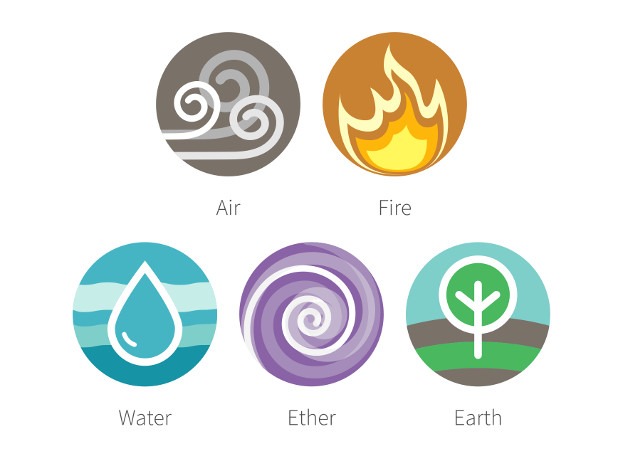Elements in Ayurveda
In the previous blog post, I tried to mention what Ayurveda is and what is the purpose of it. Ayurveda explains the body and organ system with the three states of being (“dosha”) in the human world and the five elements in nature; earth, water, fire, air and space (ether). The formation of these elements is also explained by the existential philosophy. The light vibrations that emerged during existence created the sound of the “om (a – u – m)”, the first cosmic vibration. A “space” is required for any kind of existence. The space represents a potential. In fact, “air” is the element that emerges at the end of the movements in space in the universe. While the heat created by the friction in the movement of the air created the “fire” element, the elements melted by the heat of the fire formed “water”. The “earth” element emerged from the solidification of water to form the molecules of the earth. In this way, the elements of air, fire, water and earth were created in space.
Building Blocks: Five Basic Elements

Earth (Soil): represents the solid direction of the body. It shows rigidity, stability and hardness. It is possible to see rock and soil standing firmly against the corrosive power of water and wind. Human body also shows this earthy / solid direction; bones, cartilage, nails, muscles, tendons, skin and hair. The earth element represents all physical matter in the universe. Although we perceive bodies as solids, modern Physics describes that matter are non-matter entities consisting of intense energy. Planets, rocks, trees, organs and cells are examples of the earth element. We can say that all solid materials in the body, represented by organs and cells in human physiology, are fed by the energy of the earth element.
Water: represents the change, the force of gravity and adhesion. Interplanetary gravity, combinations within molecules, and the love of two lovers are all phenomena realized by the element of water. In the outside world, we see the movement of water in a cycle of evaporation – clouds – condensation – rain. In nature, we see that water erodes the soil and carries even immovable things towards the seas. Body secretions, blood, joint fluids, cytoplasm in the cell are just a few examples of the water element in the body. Our blood and other fluids move between cells and through veins to energize, carry out waste, regulate body temperature, fight diseases, and carry hormonal information. Water is a vital element. For example, if the dehydration caused by diarrhea and vomiting is not eliminated immediately, the patient could lose his/her life.
Fire: The source of light and fire in the solar system is the sun. The heat of the sun melts the ice and turns it into water and again turns it into steam with the effect of heat. Fire is considered a formless form. The source of fire in the human body is metabolism. The main feature of the fire element is metabolism and transformation. Many fields, starting from the nuclear reactions in the stars and to the energy production in the cells, are triggered by the energy of fire. Fireworks in the digestive system. In the gray matter of brain cells, fire manifests as intelligence. Body temperature, digestion, thinking processes, and vision are all functions of the fire in the body. All metabolism and enzyme systems are controlled by this element.
Air: is the space in motion. The basic characteristic of the air element is motion. The air element is the most important factor that directs the movement of energy and information in living creatures, although it also concerns the movement of galaxies in the universe. We feel the air flowing down our throats and into our lungs. When we cut off the air for more than a few minutes, we realize how essential air is for living. The air in the human body manifests itself in the heartbeat, muscle movements, expansion and contraction of the lungs, and movement of the abdominal wall and intestines. The air in the body directs all the movements of the central nervous system.
Space (Ether): is the space in which everything occurs. The space, which has the potential to create, has created the basis for all other elements to be formed. The space element is seen in many organs and tissues in the human body such as the mouth, nose, digestive system, and respiratory system.
In Ayurveda, these elements create a combination of two among themselves and form three types of bioenergy which we call as “doshas”; Vata, Pitta and Kapha. In the next blog post, it is going to be discussed what are these doshas and what are the main characteristics of each of them.
Want to see what is more? Follow me!
See you on my next post!
Anıl Uzun
